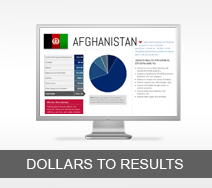Agriculture
Accelerating market-led growth in agriculture
The purpose of USAID’s agriculture program is to improve food security, increase agricultural productivity and rural employment, and improve family incomes and well-being. Improved job opportunities and incomes also reduce pressures on the poor to grow opium poppy.
Democracy & Governance
Strengthening institutions for good governance
USAID’s Democracy and Governance program supports the establishment of a broadly accepted national government that promotes national unity and effectively serves the needs of the Afghan people. USAID helps develop the capacity of key institutions including the Independent Electoral Commission, the National Assembly, the Supreme Court, and target ministries and institutions of the executive branch such as the Independent Directorate for Local Governance, and the Civil Service Commission. USAID also provides training to Afghan civil society organizations to advocate for society-led reforms.
Economic Growth
Reducing poverty by promoting economic growth
The primary goal of USAID/Afghanistan’s Economic Growth program is to promote a thriving economy led by the private sector, as stable political and economic conditions prevent terrorism from flourishing in fragile or failing states. In order to improve economic policy and the business environment, USAID aims to continue to promote macroeconomic reform, revenue collection, and privatization of state-owned enterprises. To continue to assist in the improvement of private sector competitiveness, USAID will continue to develop industrial business parks, assist Afghan firms to compete in the global market, and support SMEs.
Education
Increasing access to quality education and suitable learning environments
USAID’s education strategy is designed to support basic education, higher education, and literacy combined with productive skills training for out of school youth and adults. In each of these sub-sectors, USAID focuses on improving teaching, institutional systems that sustain quality teaching, providing instructional materials, and constructing learning spaces. Program activities include training and technical assistance to strengthen teacher and administrator performance; development of teacher-training curricula, performance standards, a teacher certification system, and information systems; printing of textbooks; and construction of classrooms and teacher education facilities.
Gender & Participant Training
Gender & Participant Training
The United States is committed to helping remove constraints on women’s potential. Women’s participation in reconstruction will have transformational impacts on Afghanistan. To achieve this, USAID supports legal rights for women, helps them gain access to public services and jobs, builds their capacity, and encourages their inclusion in public life. USAID programs aim to ensure a better future for Afghanistan’s women, their families, communities, and country.
Health
Increasing access of women and children to quality basic health services
In order to create conditions for stability in Afghanistan, USAID health projects are designed to improve the health status of the general population. The projects aim to train essential health care professionals, educate Afghans about better health habits, enhance provider performance, and develop and implement quality assurance systems. Basic health care for rural communities is a priority for USAID/Afghanistan, with a primary focus on women and children’s health.
Infrastructure
Expand and improve access to economic and social infrastructure
USAID began building roads, schools, and clinics in 2002 to demonstrate immediate progress to the Afghan people. While these projects continue, USAID is shifting its focus to improve energy and power. The building and refurbishing of infrastructure boosts economic growth and agricultural yields, connects rural Afghans to services, and provides schools, clinics, and courthouses for its citizens.
Stabilization
Strengthening the reach and legitimacy of the central government in outlying regions
Stabilization programs are designed to improve security, extend the reach of the Afghan government, and facilitate reconstruction in priority provinces. Their core objective is to implement projects that will improve stability so that more traditional forms of development assistance can resume.









Comment
Make a general inquiry or suggest an improvement.